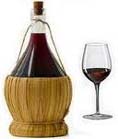Plates - 8
from Italian Traditional Food
Plates in general
Check out these great Italian ideas at Amazon for Italian food and kitchen ideas.
<< Previous Page
8
More info about the potted history of plates
....
A little knowledge ....
How many people, browsing through
junk shops, hunting in family cupboars or turning out the attic, suddenly come across a neglected piece of china?
An odd cup, perhaps, a large, old-fashioned plate of an elaborate teapot? Where did it come from? Could it be
valuable? Who made it, and when?
Well, hopefully by having read
through these articles you may have gained a little knowledge on the subject. A little knowledge, just for once, is
not a dangerous thing if it leads you to seek out more information for yourself. After all, each past age had its
own particular stamp and style, and it is only by learning to recognise the "trademarks" that you come truly to
value the best of its type.
For people nowadays, while
appreciating the speed and convenience of modern living, are beginning to admire the work of the master craftsman.
More and more objects, once considered junk, are finding their way into modern homes, to be polished and displayed
with pride. Your chipped Rockingham plate, your bent and twisted spoon may not have much market value, but it is
nevertheless a piece of domestic history. And if you don't intend to start collecting for yourself, there are
always museums to visit, stately homes on view.
In fact, it's by studying the
objects people used, their tastes and fancies, fads and fashions, that we learn more about our predecessors than
any textbook can tell us.
Here is some information about some
of the great names in British pottery. The term "Staffordshire", for example, covers a multitude of the best-known
names in English pottery, among them Minton, Spode and, of course, Wedgwood. In the early days, some porcelain was
produced, notably by New Hall which manufactured "hard paste" porcelain and Longton Hall which made the "soft
paste". The secret of hard paste, with its colder, firmer feel, was discovered long ago by the Chinese. Soft paste,
a kind of 18th century European substitute, is warmer to the touch, looks more porous, and sometimes its glaze
seems to be slightly smeared.
At the same time, good, strong
earthenware was being made for general consumption, and a little later Josiah Spode - the son of the firm's founder
- helped to pioneer English bone china - rather like a compromise between the two. With a much more delicate
appearance than earthenware, yet stronger and certainly cheaper than porcelain, it proved a winner. A great deal of
tableware such as plates has been born of this splendid British
compromise.
Page 7 of this Italian Traditional Food article on plates can be found on the previous
page.
<<
Previous Page
8
Read more Italian traditional food related articles here

Copyright © 2009 -
. All Rights Reserved Worldwide. Italian Traditional Food
You may not reprint articles from this website
without the written permission of the site owner.
Disclaimer: Articles on this
Website are provided for information purposes only. Italiantraditionalfood.com does not accept any responsibility
or liability for the use or misuse of the article content on this site or reliance by any person on the site's
contents.
| 


 Digg
Digg Stumbleupon
Stumbleupon Google Bookmarks
Google Bookmarks Delicious
Delicious Twitter
Twitter Facebook
Facebook Yahoo My Web
Yahoo My Web Reddit
Reddit